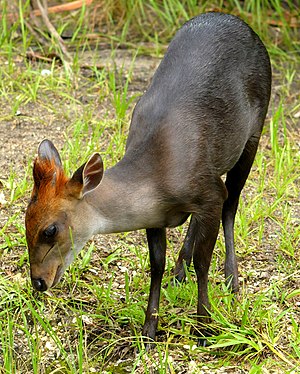Black duiker
| Black duiker | ||||||||||||
|---|---|---|---|---|---|---|---|---|---|---|---|---|

Black duiker ( Cephalophus niger ) |
||||||||||||
| Systematics | ||||||||||||
|
||||||||||||
| Scientific name | ||||||||||||
| Cephalophus niger | ||||||||||||
| Gray , 1846 |
The black duiker ( Cephalophus niger ) is a small antelope found in West Africa from Sierra Leone to southwestern Nigeria .
features
The black duiker reaches a head-trunk length of 80 to 100 cm, a height at the withers of 45 to 55 cm and a weight of 15 to 20 kg. Its tail is 7 to 14 cm long, the horns of the males 7.5 to 17.5 cm, those of the females 2.5 to 3 cm. Generally, he is a sturdier built duiker with a long body and short, strong legs. Females are usually larger than males.
The fur is brown-black to black, with the back of the animals being darker. The head, throat and chest are lighter, the top of the head and the forehead are red-brown, the outside of the ears black-brown, the inside of the ears reddish-brown. The middle of the forehead can be black. The inside of the legs are yellow-brown. The black tail has individual light hairs, its end tassel is black and white. Inguinal glands are absent, the dewclaws are small. The horns have a round cross-section and run straight, in males they are between 7.2 and 9.4 cm long, in females with a maximum of 3.1 cm in length significantly shorter. Their base is slightly ribbed.
Way of life
The black duiker lives on the edges of forests and in thickets and bushy, more open terrain, sometimes also in gallery forests. Mostly it is diurnal and solitary, only rarely do you come across small groups of a maximum of three individuals. These then consist of males, females and the offspring; nothing is known about the stability of such associations. The diet consists of fruits, which make up 88% of all plants consumed. These include those of the milkweed family , figs , oil palms and laurel family . Other soft plant parts such as leaves play a subordinate role and are only eaten when they are juicy. The fruits can be up to 6 cm in diameter, larger or tough ones are avoided.
The mating season of the black duckling is all year round, but a larger number of offspring is born between November and January. The gestation period lasts 126 days and is therefore comparatively short, after which only one young is usually born. This weighs an average of 1.94 kg and is breastfed for around 90 days. The birth interval is seven and a half months. In captivity, the black duiker can live up to 14 years.
Threat and protection
The total population of the black duiker is estimated at around 100,000 animals. In its range, however, it is a frequently hunted animal and serves as a meat supplier. The IUCN states that stocks are declining, but the black duiker is currently considered a least concern (“not endangered”).
literature
- Theodor Haltorth , Helmut Diller: Mammals of Africa and Madagascar (= BLV -bestungsbuch. Vol. 19). BLV Verlags-Gesellschaft, Munich et al. 1977, ISBN 3-405-11392-X .
- Jonathan Kingdon: The Kingdon Pocket Guide to African Mammals. A & C Black Publishers Ltd., London 2004, ISBN 0-7136-6981-0 .
- Colin P. Groves and David M. Leslie Jr .: Family Bovidae (Hollow-horned Ruminants). In: Don E. Wilson and Russell A. Mittermeier (eds.): Handbook of the Mammals of the World. Volume 2: Hooved Mammals. Lynx Edicions, Barcelona 2011, ISBN 978-84-96553-77-4 , pp. 764-765.
- Cephalophus niger onthe IUCN 2012 Red List of Threatened Species . Listed by: IUCN SSC Antelope Specialist Group, 2008. Retrieved October 23, 2012.